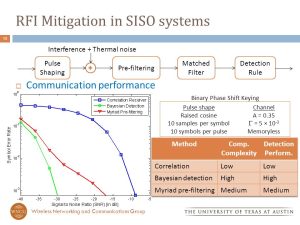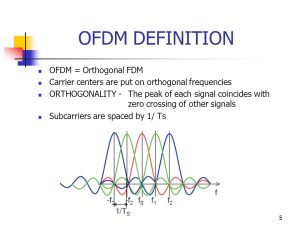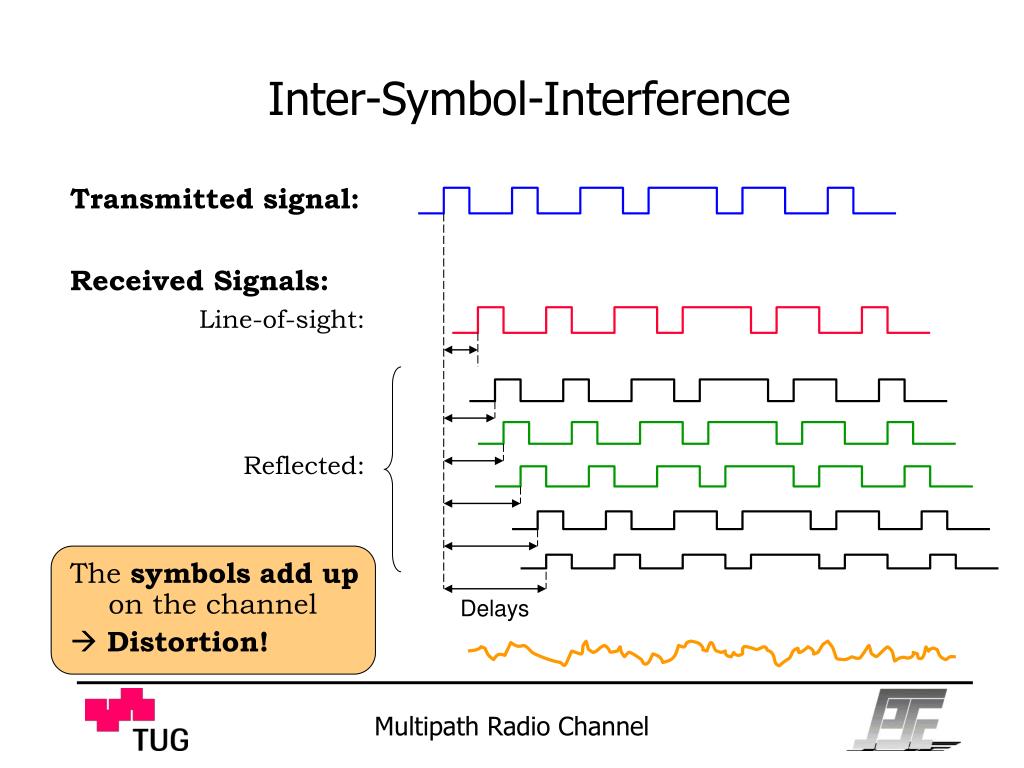The perplexing issue of interference plagues wireless transmission, introducing errors and diminishing the data quality during transmission. An effective solution to combat this problem is Orthogonal Frequency Division Multiplexing (OFDM), which partitions the frequency spectrum into various subcarriers, each with its own stream of information.

However, in mobile settings where movement causes Doppler shifts, Inter-Carrier Interference (ICI) can emerge as a hindering factor. To confront this obstacle head-on, LTE adopts orthogonal frequency division multiplexing access (OFDMA), which allocates different subcarriers to separate users for optimal bandwidth utilization.
Orthogonality remains at the crux of OFDM transmission since it guarantees that no overlap will occur between subcarriers, effectively reducing interference. This implies that even if one carrier falls prey to interference, other carriers remain unaffected and continue transmitting smoothly.
Furthermore, cyclic prefix serves as an additional measure against Inter-Symbol Interference (ISI), appended at the commencement of each symbol within an OFDM system to furnish a guard interval between symbols and eliminate any overlapping signals from previous symbols.
Conclusively speaking, mitigating interference in wireless transmissions stands paramount for ensuring reliable communication. The use of Orthogonal Frequency Division Multiplexing (OFDM) techniques such as subcarrier allocation and orthogonality represent significant strides towards minimizing interference while employing methods like cyclic prefix and frequency domain equalization further augment signal quality. These measures prove critical towards achieving top-tier wireless transmissions in contemporary mobile environments such as LTE networks.
Orthogonal Frequency Division Multiplexing (OFDM) and its Role in Wireless Communications
Contents
- 1 Orthogonal Frequency Division Multiplexing (OFDM) and its Role in Wireless Communications
- 2 Understanding the Use of Subcarriers in OFDM Systems
- 3 The Importance of Orthogonality in OFDM Transmission
- 4 Mitigating Inter-Symbol Interference (ISI) in OFDM Systems
- 5 Cyclic Prefix and its Role in Reducing ISI in OFDM Transmission
- 6 Frequency Domain Equalization and its Role in OFDM Signal Processing
- 7 The Role of Fast Fourier Transform (FFT) in OFDM Signal Processing
The communication world has been revolutionized by the groundbreaking modulation technique known as Orthogonal Frequency Division Multiplexing (OFDM). OFDM is designed to transmit data over multiple subcarriers that are orthogonal and capable of carrying independent information simultaneously. This feature makes it perfect for high-speed data transmission in environments where multipath interference poses a challenge.

However, there’s another technology called Orthogonal Frequency Division Multiple Access (OFDMA), which builds on the underlying principles of OFDM but incorporates an access scheme that allows several users to share the same frequency band by allocating individual subcarriers to each user. This approach optimizes spectrum utilization while reducing interference between users.
Traditionally, single carrier systems have been used in RF transmissions; however, they suffer from Inter-Symbol Interference (ISI) due to channel distortion caused by multipath propagation. Conversely, OFDM divides the transmitted signal into narrowband signals carried by closely spaced subcarriers that are less susceptible to ISI effects. Furthermore, cyclic prefix added at the beginning of each OFDM symbol helps mitigate ISI and inter-carrier interference (ICI), improving overall performance.
In conclusion, OFDM’s ability to divide a wideband signal into many narrowband subcarriers provides numerous advantages over traditional single carrier systems such as reduced susceptibility to multipath fading and improved spectral efficiency through better utilization of available bandwidths. Additionally, its use in conjunction with access schemes like OFDMA further improves system capacity while minimizing inter-user interference – making it a fascinating technology indeed!
Understanding the Use of Subcarriers in OFDM Systems
OFDM, the widely adopted modulation scheme for wireless communication systems, offers a perplexing yet robust solution. It works by dividing the available bandwidth into multiple subcarriers that carry separate data streams – an idea so bursty and brilliant! But what’s even more fascinating is how it makes these subcarriers orthogonal to each other. Yes, you heard me right – orthogonal! By doing this, OFDM significantly reduces interference between them.
Now let’s delve deeper into its working mechanism. In an OFDM system, the carrier frequencies are spaced apart by an integer multiple of the inverse of symbol time in such a way that all subcarriers become orthogonal and do not interfere with one another. Astonishingly enough, IEEE 802.11a/g/n/ac standards employ OFDM as their underlying modulation technique for wireless LANs.
But wait; there’s more to it than meets the eye! The number of subcarriers used in an OFDM system varies based on several parameters like channel bandwidth, FFT size and guard interval duration. For instance, LTE networks typically have 12 or 15 subcarriers per resource block depending on whether it’s uplink or downlink transmission respectively – mind-boggling stuff!
The use of subcarriers also plays a crucial role in managing multipath fading effects by spreading out energy across different frequencies and reducing intersymbol interference (ISI). How ingenious is that?
The Importance of Orthogonality in OFDM Transmission
The enigmatic Orthogonal Frequency Division Multiplexing (OFDM) has proven itself to be an indispensable technique in the realm of wireless communications, deftly mitigating multipath interference and frequency offset. The very crux of OFDM transmission lies in its orthogonality – a concept that guarantees subcarriers don’t interfere with each other, resulting in optimal utilization of available bandwidth. This novel approach enables high data rates even in environments fraught with significant delay spread.
But wait, there’s more! OFDM possesses an exceptional ability to handle Doppler shifts caused by motion or mobility – making it ideal for high-speed communication systems such as 4G LTE and 5G NR which utilize frequencies up to several GHz. This is achieved through the preservation of orthogonality between subcarriers despite any changes in frequency due to Doppler shift.
To maintain this sacred orthogonality between subcarriers, cyclic prefix (CP) is added at the beginning of each symbol before transmission. CP copies the end part of a symbol and appends it at the beginning thus creating a guard interval that helps mitigate inter-symbol interference (ISI). Moreover, CP plays another crucial role – reducing multipath interference by facilitating identification between delayed versions of transmitted signals.
In summation: Orthogonality is indisputably paramount when it comes to OFDM transmission since it ensures efficient use of available bandwidth while eliminating various types of interference such as ISI and multipath. By employing cutting-edge techniques like coding, CP insertion and frequency domain equalization (FDE), OFDMA can further bolster spectral efficiency while boosting data rate capabilities beyond those achievable by traditional single carrier systems.
Mitigating Inter-Symbol Interference (ISI) in OFDM Systems
The OFDM communication system can be a perplexing beast, as Inter-Symbol Interference (ISI) lurks in the frequency domain due to adjacent symbol overlap. The nasty culprit behind such interference is none other than multipath propagation and channel fading that wreak havoc on transmission quality via air interface. But fear not! OFDM has a bursty solution called Frequency Division Multiplexing (FDM), which chops wideband signals into multiple narrowband subcarriers.
Each of these subcarriers carries its own modulated data stream, utilizing BPSK or QAM modulation with a symbol time equivalent to the inverse of its bandwidth. With many subcarriers rather than just one carrier, ISI gets knocked down since each symbol occupies less time and overlaps minimally with other symbols. And get this – each OFDM carrier boasts different frequencies that are orthogonal to one another i.e., no interference occurs even when transmitted simultaneously.
To handle signals efficiently in both baseband and passband domains, Fast Fourier Transform (FFT) is used extensively in OFDM systems for efficient computation of complex mathematical operations on digital signals. FFT transforms discrete-time samples from time-domain to frequency-domain representation while preserving their information content – talk about impressive! Additionally, channel coding techniques like error correction codes boost signal robustness against noise interference during RF channel transmission.
Utilizing FDM and FFT techniques along with proper channel coding schemes such as one-bit feedback algorithms depending upon varying channel conditions can help mitigate ISI effectively in OFDM systems without compromising overall performance metrics like throughput or latency – now that’s what we call bursting with potential!
Cyclic Prefix and its Role in Reducing ISI in OFDM Transmission
The perplexing conundrum of wireless communications lies in the daunting task of mitigating interference, especially within mobile environments. Enter Orthogonal Frequency Division Multiplex (OFDM), widely embraced as a solution to this mind-bending problem due to its ability to assuage inter-symbol interference (ISI) and co-channel/adjacent channel interference – but alas, OFDM transmission is not without its challenges. One such issue is inter-carrier interference (ICI). Fear not though, for there exists a technique known as Cyclic Prefix (CP) which comes to the rescue.
The CP length’s magnitude surpasses that of the delay spread of the channel; this ensures that during transmission, each symbol’s time-domain signal does not interfere with others’ signals. The CP period can be calculated based on factors such as symbol length and bit stream rate determined by sub-carriers’ frequency spacing and number used.
With CP in place, OFDM systems guarantee a guard band between adjacent symbols transmitted at different frequencies within a time-frequency grid. This reduces both ISI caused by multipath propagation and ICI caused by frequency offset errors or Doppler shifts resulting from mobility. Furthermore, CP facilitates efficient use of Fast Fourier Transform (FFT) algorithms for signal processing since it converts time-domain signals into their equivalent frequency domain representations.
In conclusion, cyclic prefix plays an indispensable role in reducing the befuddling effects of ISI and ICI in OFDM transmissions while ensuring orthogonality among sub-carriers with sufficient guard bands between adjacent symbols transmitted at different frequencies within a time-frequency grid – making reliable high-speed wireless communication possible even under challenging mobile conditions characterized by rampant multipath fading effects!
Frequency Domain Equalization and its Role in OFDM Signal Processing
The perplexing and bursty world of wireless signal processing demands a powerful tool to combat interference: Frequency Domain Equalization. This technique, integral to OFDM systems, harnesses the power of discrete Fourier transforms to mitigate the scourge of inter-symbol interference (ISI). With Doppler effects and channel uses constantly threatening transmission quality, transmitting multiple information symbols simultaneously can be a risky proposition.
To circumvent this challenge, Frequency Domain Equalization comes into play by breaking down each symbol into smaller sub-symbols that are transmitted over different subcarriers. This allows for better ISI management as only one symbol would bear the brunt of any given frequency selective fading channel at any time. In addition, since OFDM and OFDMA make use of a larger number of subcarriers per symbol than traditional single-carrier modulation techniques do, they have become popular choices for mobile communication systems.
It’s no exaggeration when we say that Frequency Domain Equalization is essential in mitigating interference in wireless transmissions. When combined with cyclic prefixing and orthogonality principles, this technique can effectively reduce or eliminate interferences such as Inter-Symbol Interference altogether. As technology continues its upward trajectory, these techniques will continue to play an indispensable role in ensuring efficient wireless communications worldwide across various industries and applications alike.
The Role of Fast Fourier Transform (FFT) in OFDM Signal Processing
The role of Fast Fourier Transform (FFT) in OFDM signal processing is nothing short of critical. By converting time-domain signals into frequency domain signals, FFT helps detect and correct errors caused by external factors like Doppler shift or other interferences. This technique has been widely adopted in various communication systems such as digital video broadcasting and cellular networks.
Efficient use of available bandwidth requires the condition of orthogonality between subcarriers to be met. FFT ensures this condition, allowing multiple subcarriers to be used without interfering with each other. Frequency domain equalization techniques are then used to process data transmitted through these subcarriers, eliminating any interference caused during transmission.
One significant advantage of using FFT in OFDM systems is its better spectral efficiency due to redundancy on both sides of the spectrum. This redundancy can increase the rate at which data is transmitted while maintaining high accuracy levels. Additionally, cyclic prefix insertion enabled by FFT reduces inter-symbol interference (ISI) by adding guard intervals at the right-hand side before transmission occurs.
These features make FFT an indispensable tool for improving wireless communication performance and reducing errors from external factors like Doppler shifts or noise from other sources. Researchers have presented new methods for optimizing OFDM systems using advanced algorithms based on FFT analysis at recent vehicular technology conferences, further enhancing their performance and reliability – truly mind-boggling!


